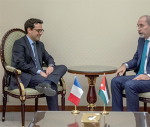You are here
China’s Belt Road Initiative comes with developmental opportunities, challenges
Apr 17,2022 - Last updated at Apr 17,2022
China’s industrial development and its strong economic growth strengthen its relations with the Middle East and North Africa region, the Asian countries and beyond. The old Silk Road, which recently became known as the China’s Belt and Road Initiative (BRI) is one of them.
Historically, the BRI is reminiscent of the old Silk Road which was according to Yihong Xiao, professor of Accounting and Finance at Bridgewater State University (BSU), “a network of caravan and sea routes [that] stimulated the economic, cultural, political, and religious interactions between East and West”. From one perspective, the new Silk Roads are imagined as part of a vast region comprised of maritime and land routes which President Xi Jinping of China conceived and lunched with massive global infrastructure and investment in 2013.
The “BRI is a geoeconomics strategy”, said Dr. Grant Rhode, a senior lecturer in International Relations at the Pardee School of Global Studies at Boston University. Dr. Rhode noted, “Understanding the global multi-million dollars projects that the BRI has become, required the inputs of scholars from full ranges” in academia and research centres.
In response, the Asian Studies Programme, the Global Programmes, and the Middle East and North Africa Studies at BSU organised a forum on “China’s Belt and Road Initiatives: Development opportunities and Challenges”. The forum, also supported by the US Department of Education, examined the frameworks and potential effects of the BRI. Dr. Wing-kia, associate provost for Global Engagement at BSU pointed out that the “BRI forum was distinguished for its breadth of case studies relating to different Asian and MENA regions as it addresses China’s ambitions for economic integration in Eurasia and its enduring challenges for implementation and governance”. Analysts at the forum raised a critical question; will the participating parties in BRI be able to mitigate challenges?
Dr Khaled Al Shogran, editor-in-chief of the Al Rai daily newspaper in Jordan pointed out, “In 2017, the Chinese Council for the Development of International Trade and the Jordan Chamber of Commerce signed a Memorandum of Understanding [MoU] to promote Jordan investments between the two countries and the development of trade relations.” In the words of BSU Provost Karim Ismaili, the BRI forum shed light “on the status of the Belt and Road enterprise and innovativeness to develop international opportunities that are more equivalent, balanced, and to achieve sustainable growth in economy, education, gender equity, and to promote social justice and clean environment”.
It should be recognised that BRI showcases a strong global developmental platform in the 21st century and the multi benefits and enormous impact of the BRI on global economic structure in the developing world. For China, BRI revolves around “the concept of peace, cooperation, development, and mutual interests”.
Nevertheless, this strategy does not set well with the political and economic thinking of some Western countries. For instance, the United States announced in 2020, a package of initiatives to offer counterpoint to BRI’s projects. The package includes what’s called “Blue Dot Network” to “establish shared standards for global infrastructure development”, along with another project supported by the International Development Finance Cooperation (DFC). These projects are part of a broader US “Indo-Pacific Economic Vision” announced in 2018 as a counter to BRI. To this extent, the United States does not seem to understandthe importance of BRI for MENA.
Expanding this point of view, Dr. Nader Habibi, professor of Economics of the Middle East at Brandeis University examined the Chinese and Arab Gulf mutual interests “China has the fastest growing market for energy in the world”which would benefit the Gulf countries, as they own the largest concentration of oil and natural gas reserves. BSU Professor of Social Work Jonghyun Lee expounded on the interests of other countries in taking part in the BRI including South Korea. Professor Lee noted,“In 2018 Moon Ja-In, the president of South Korea, expressed South Korea’s interest in participating in the BRI and currently South Korea is the fifth largest shareholder of the Asian Infrastructure Investment Bank [AIIB] the main financing agency of the BRI.”
Simply, BRI is a developmental project rather than political one.
The author is academic director of Global Programmes Bridgewater State University (BSU)












